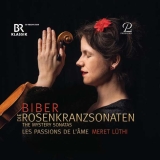Nach den Partiten Harmonia Artificiosa-Ariosa und einer Einspielung mit anderen Sonaten des Komponisten Heinrich Ignaz Franz Biber widmen sich Meret Lüthi und ihr Ensemble Les Passions de l’Ame nun dem sechzehnteiligen Zyklus der Rosenkranzsonaten mit den fünf freudenhaften, den fünf schmerzhaften und den fünf glorreichen Sonaten sowie der sich anschließenden Schutzengel-Passacaglia.
Da hätte es auch sehr verwundert, wenn die Interpreten mit dem Komponisten und seiner Musik keine enge Verbindung aufgebaut hätten und sich dem Metier zögerlich nähern müssten. Vom ersten Ton an spürt man die große Vertrautheit mit dieser Ausdruckswelt und, dass sich die Musiker ebenso selbstbewusst wie auch in die Musik horchend in diese gut zwei Stunden hineinknien. Dabei lassen sie keine Zweifel aufkommen, dass sie der Musik nicht nur gewachsen sind, sondern die Darstellung beherrschen.
Entsprechend des thematischen Hintergrundes rückt hier eine ruhige auf Ausdruck bedachte Lesart in den Vordergrund, ohne deswegen virtuoses Spiel zu verweigern, wenn es angezeigt ist. Die konzeptionelle Ausleuchtung der Werke trägt über die gesamte Zeitspanne von mehr als zwei Stunden. Hier werden reizvolle barocke Klangwelten im schönen Gewand geboten.
Dennoch schleicht sich irgendwann die Frage heran, ob etwa die Skordierung, die gerade diese Stücke mit kennzeichnet, nicht noch zu einem abwechslungs- und kontrastreicheren Spektrum hätte führen müssen. So eröffnet die Skordatur gerade auch die Chance, manchen Satz noch mutiger aufgeraut klingen zu lassen, um so etwa das Schmerzhafte herauszustellen. Auch in der Tempodisposition ließe sich noch manche Nuance heben. Denkt man etwa die Aufnahmen von Reinhard Goebel, John Holloway oder Hélène Schmitt jeweils mit Ensemble, so bieten diese noch mehr Details und damit auch eine reichere Auslese aus dem Notentext.
Auch bei Lüthi finden sich gelegentlich spannende Hörbeispiele, wie eine zupackendere Herangehensweise im Kopfsatz der elften Sonate oder eine fast volksmusikhaft wirkende Solidität in der Aria von Himmelfahrt Mariä. Aber davon hätte man sich mehr gewünscht.
Auch die Passacaglia bleibt ischämisch. Sicherlich, ein Engel ist ein blutleeres Wesen, aber wenn er denn schützen soll, muss er doch auch eingreifen und helfen können und darf dann nicht blass bleiben. Diese Passacaglia hat etwas von einem beruhigen Nachtstück, nicht von einem Wesen, das sich kümmert.
Im Heft zur Ausgabe sind die in der Handschrift der Noten jeder Sonate vorangestellten Rosenkranz-Vignetten, Kupferstichmedaillons von Paul Seel eingeklebt. Diese Medaillons werden anhand kurzer Texte erläutert. Bis auf wenige Reminiszenzen an thematisch passende katholische Kirchenlieder finden sich keine Bezüge zur Musik. Dieser einfallsreiche Zyklus von Variationen dürfte den Widmungsträger, Fürstbischof Max Gandolf von Kuenburg in Salzburg, erfreut haben. Mit dem Einfallsreichtum zur Nutzung der Scordatura ist Bibers Werk einmalig.
After the Harmonia Artificiosa-Ariosa partitas and a recording with other sonatas by the composer Heinrich Ignaz Franz Biber, Meret Lüthi and her ensemble Les Passions de l’Ame now release the sixteen-part cycle of the Rosary Sonatas with the Five Joyful, the Five Sorrowful and the Five Glorious Sonatas as well as the subsequent Guardian Angel Passacaglia.
It would have been very surprising if the performers had not established a close connection with the composer and his music and had to approach the metier hesitantly. From the first note one senses the great familiarity with this world of expression and that the musicians play this good two hours with much self-confidence.
Corresponding to the thematic background, a calm reading with a focus on expression comes to the fore, without therefore refusing virtuoso playing when it is indicated. The conceptual illumination of the works carries over the entire time span of more than two hours. Charming baroque sound worlds are offered here in a beautiful guise.
Nevertheless, at some point the question comes up whether the scordatura, which characterizes these pieces in particular, should not have led to a more varied and contrasting spectrum. The scordatura opens up the chance to make some movements sound even more courageously roughened, in order to emphasize the painfulness, for example. Also in the tempo disposition some nuances could be welcome. If one considers, for example, the recordings by Reinhard Goebel, John Holloway or Hélène Schmitt each with ensemble, these offer even more detail and thus also a richer selection from the musical text. Even with Lüthi there are occasional exciting examples, such as a more gripping approach in the opening movement of the eleventh sonata or an almost folk-music-like solidity in the aria of Assumption of the Virgin. But one would have wished for more of this.
Also the Passacaglia remains ischemic. Surely, an angel is an anemic being, but if he is supposed to protect, he must also be able to intervene and help and must not then remain pale. This Passacaglia has something of a soothing night piece, not of a being that cares.
In the booklet accompanying the edition, the rosary vignettes, copperplate medallions by Paul Seel, preceding each sonata in the manuscript of the notes. These medallions are explained by means of short texts. Except for a few reminiscences of thematically appropriate Catholic hymns, there are no references to the music. This imaginative cycle of variations must have pleased the dedicatee, Prince-Bishop Max Gandolf von Kuenburg in Salzburg. With the ingenuity to use the scordatura, Biber’s work is unique.
























